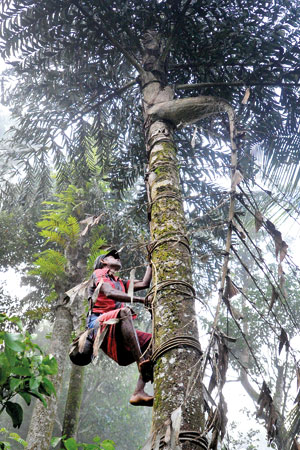Jaggery from termite mounds
View(s):Little Subangi got excited when she came to know that jaggery could be made from termite mound clay! So far she had known that clay could be used to make little things for herself to play with, such as toy birds and toy animals. There was another reason for little Subangi to be excited about this new discovery of making jaggery: There were humongous termite mounds in her large home garden in Bandaragama in the Kalutara district.

Collecting kithul for jaggery. Pic by Amila Gamage
Some men come to her home on bicycles from time to time. They asked permission from her mother to cut the termite mounds to get some mound earth. Her mother didn’t mind it and, always allowed them. Then, they used to cut the mounds, filled the sacks with earth, tied them at the back of their bicycles and, go away riding the bicycles. Subangi was watching all these happenings.
One day, Subangi’s mother who apparently didn’t know why they gathered termite mound clay, asked the men: “What are you doing with mound clay?”
“We make jaggery,” one man said. And little Subangi who was with the mother at that moment heard it clearly. What she heard didn’t get faded away from her memory even after so many years and, she still remembers it.
Forty five years later
About forty five years later, today we don’t introduce her as “little Subangi”. She is now known as Prof. Subangi Herath, a Professor of Sociology at Colombo University. She recalled her memory and told us the above incident during the time of our gathering at the Senior Common Room of the Faculty. Jaggery is a close substitute for sugar and, made of flower sap of a variety of palm trees such as coconut and kithul. In the 1970s, sugar was subject to severe import controls. It was a strategy to promote domestic production and to save foreign exchange. Import controls were very common, while many consumer goods including essential foodstuffs were placed under excessive import controls.
It was a time when Sri Lanka was marching towards a “socialist” economy. The Budget Speech of 1970 clearly spelled out the newly elected United Front government’s objective of establishing a socialist economy. Therefore, what was to produce and who should produce it were decided by the government.
Government as the producer
Government was producing many things at the time, while the products were distributed throughout the country and sold to people through the cooperative shop network.
There were government corporations and government boards to produce many things such as sugar, tea, textile, paper, chemicals, fertilizer, salt, timber, cement, steel, mineral sand, gem, cashew, coconut, palmyrah and milk. You name a product, you can find a government agency established at the time to look after that. Many of these corporations, boards and enterprises continued to exist up to date, even if Sri Lanka made a U-turn in its policy-making.
As far as sugar is concerned, Sri Lanka had a couple of government-owned sugar factories – in fact, rhetorically the largest ones in Asia, established with the support of socialist countries including Soviet Russia.
 Their production was, however, not sufficient to meet the domestic demand so that average households hardly had sugar at their home. Besides, the sugar factories were also not in operation half of the year, because of the lack of inputs, primarily sugar cane. But the salaries and wages continued to be paid even if workers had to stay idle without work.
Their production was, however, not sufficient to meet the domestic demand so that average households hardly had sugar at their home. Besides, the sugar factories were also not in operation half of the year, because of the lack of inputs, primarily sugar cane. But the salaries and wages continued to be paid even if workers had to stay idle without work.
Economic data at the time shows that annually on average about half of the capacity of the government-owned factories was unutilised!
Emerging production
Small and medium enterprises (SMEs) as well as cottage industries such as jaggery production emerged targeting the domestic supply shortage. Many of these enterprises didn’t have a business vision and strategy. They didn’t have any idea of becoming “big enterprises” or targeting export markets.
The Government also had passed a Business Acquisitions Act providing powers to the state to take over any business which employed more than 100 workers. No businessman wanted to expand a business and, thereby to become a victim of the government takeover; so they preferred to remain small.
The export market was a nightmare for many businesses: How can we reach the export market and sell jaggery made of termite mound clay? The business purpose of many production activities was to make money somehow out of the domestic supply shortage.
The main issue of this production was that producers didn’t have a “competition” on the one hand and, consumers didn’t have a “choice” on the other hand. The two problems are the two sides of the same coin.
Competition and choice
Economic policies could take away both “producer competition” and “consumer choice” from the market just like in the case of the jaggery-making story. As there was no supply of sugar or any standard substitute, even jaggery that was made by mixing clay can make profits.
Sometime ago I used to collect many stories as such from the pre-1977 policy environment of Sri Lanka; it was a time that sub-standard consumer products had conquered the local market and, when many local producers used to cheat the consumers.
Just like termite mound clay was in jaggery, sand was mixed into rice to make it heavier. Papaya seed were added to black pepper and, brick powder was mixed with red chili powder.
Since consumers didn’t have a choice of better products, all such products survived in the market making profits. Even if consumers were aware of such practices, they simply had no choice other than relying on sub-standard products.
Black market
Another outcome of domestic supply shortage was the “black market”. If anyone had the opportunity to sell consumer goods from factories or cooperative shops or smuggled from abroad, which were not uncommon issues at the time, they could be purchased secretly at exorbitant prices.
In fact, anything “imported” had the superior recognition over anything that was produced locally. Even to date, this attitude prevails in the Sri Lankan market so that “imported” is considered a better marketing strategy to raise consumer demand and claim higher prices.
Lamenting over local products
After opening the economy a significant part of the above issues pertaining to local production appeared to have disappeared, but not entirely. Even today, many consumers have a concern about what they have to purchase in the local market – an attitude that was carried forward from the past.
As the economy was open to imports, competition improved and consumer choices expanded. Although, the consumers can get cheated even today, unlike those days they have a better opportunity to avoid such situations.
What was interesting to me was that many of the subsequent economic rhetoric and even academic discussions were about “the adverse impact of open economy on domestic production.” Obviously, when sugar was freely available in the market, which consumer would want to buy jaggery made from termite mound clay?
Protection or reforms?
Also it is not difficult to find many who tend to believe and argue that “if such policies were continued for some more time, Sri Lanka would have become industrialised and developed; the mistake that we made was abandoning those policies halfway through.”
They still demand for protection, constraining market competition and consumer choices, so that the country would be better off with our own local products. A strategy to promote local production is to establish business environment by removing regulatory and infrastructure bottlenecks.
It is easy to rely on protection and, many politicians love to do that too; in fact, we have already been moving in that direction too. But it is difficult and takes time to address the regulatory and infrastructure bottlenecks that have been penalising domestic production.
(The writer is a Professor of Economics at the University of Colombo and can be reached at sirimal@econ.cmb.ac.lk)


